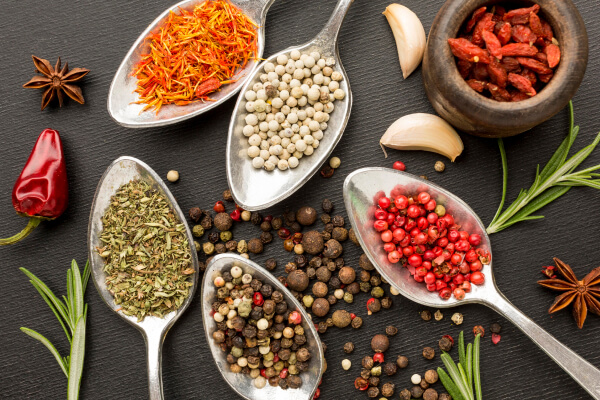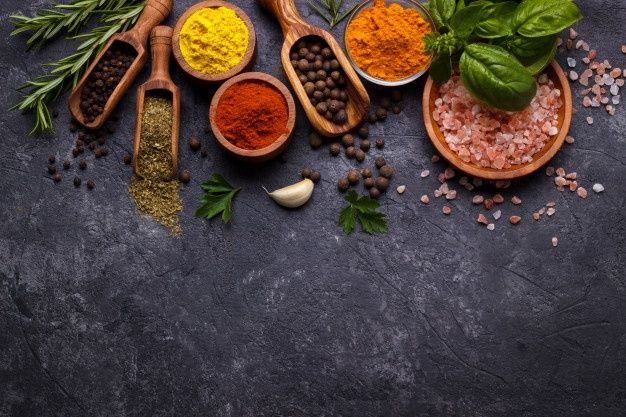

- INDIAN SPICES
Indian Spices: The Ultimate Guide to Uses, Masala Blends & Regional Varieties
- By admin
Indian Spices: The Ultimate Guide to Uses, Masala Blends & Regional Varieties
The 7 Indian Spices and Their Uses
Indian cooking is built on seven foundational spices that bring depth and complexity to dishes. Turmeric (haldi) lends its golden color and earthy flavor to curries and rice, while cumin (jeera) adds a warm, nutty aroma to tempering and spice blends. Coriander (dhania) seeds offer a citrusy sweetness, balancing savory dishes, and mustard seeds (rai) crackle in hot oil to release their pungent kick. Fenugreek (methi) seeds contribute a slightly bitter note, essential in pickles and spice mixes, whereas cardamom (elaichi) infuses both sweet and savory dishes with its floral fragrance. Cloves (laung) provide an intense, warming punch, often used in biryanis and meat curries. These Indian spices form the backbone of Indian cuisine, each playing a vital role in creating layered flavors.
Herbs and Spices Used in India
Beyond the core seven, Indian cuisine incorporates a vast array of Indian herbs and Indian spices. Asafoetida (hing) adds an umami depth to lentils, while black pepper (kali mirch) brings sharp heat to marinades and stews. Cinnamon (dalchini) sweetens desserts and biryanis, and curry leaves (kadi patta) release a citrusy aroma when fried in oil. Fresh ginger (adrak) and garlic (lehsun) form the base of countless gravies, and red chili powder (lal mirch) delivers fiery intensity. Fennel (saunf) aids digestion and flavors sweets, while bay leaves (tej patta) subtly perfume rice dishes. These ingredients, whether whole, ground, or fresh, define the diverse flavors of regional Indian cooking.
Most Popular Indian Herbs and Spices
Certain Indian spices dominate Indian kitchens due to their versatility and health benefits. Garam masala, a blend of cinnamon, cardamom, and cloves, adds warmth to curries, while turmeric and cumin appear in nearly every dal and vegetable dish. Mustard seeds and coriander seeds are staples for tempering, and dried fenugreek leaves (kasuri methi) enhance rich gravies. Fennel seeds appear in digestive teas and sweets, while saffron (kesar) elevates festive dishes like biryani and kheer. These Indian spices are not just flavor enhancers—many, like turmeric and ginger, have long been valued in Ayurveda for their healing properties.
What Is Masala Spice Made Of?
Masala refers to any blend of ground spices used in Indian cooking. Unlike single spices, masalas combine multiple flavors to create complex seasoning mixes. For example, garam masala mixes warming spices like cinnamon and cloves, while chaat masala balances tangy amchur (dried mango powder) with cumin and black salt. Sambar masala, a South Indian staple, includes coriander, fenugreek, and red chilies for a robust lentil stew. These blends can be store-bought or homemade, with each family often having its own signature ratio.
Spices in Indian Masala
The exact spices in a masala depend on its purpose. A basic garam masala contains cinnamon, cardamom, cloves, cumin, and black pepper, while tandoori masala adds paprika and garlic powder for grilled meats. Chaat masala features amchur and black salt for tangy street snacks, and biryani masala includes star anise and mace for aromatic rice dishes. Regional variations exist too—Maharashtrian goda masala uses coconut and sesame, while Bengali panch phoron blends five whole spices for tempering. The combinations are endless, each designed to enhance specific dishes.
How Many Types of Masala Are There?
India boasts countless masala varieties, each tied to regional or dish-specific traditions. Common ones include garam masala (North Indian curries), sambar masala (lentil stew), rasam masala (pepper-laced soup), and pav bhaji masala (Mumbai’s spicy vegetable mash). Others, like vindaloo masala (Goan pork curry) and korma masala (creamy Mughlai dishes), cater to particular recipes. Some blends, like Kashmiri ver masala, are hyper-local, using rare Indian spices like long pepper. The diversity reflects India’s culinary richness, where even neighboring villages might have distinct masala recipes.
Spices in Southern India
South Indian cooking is renowned for its masterful use of Indian spices, which create layers of flavor—earthy, spicy, tangy, and aromatic. Mustard seeds and fragrant curry leaves sizzle in hot oil for tempering, a technique that releases their nutty essence into dishes. Black pepper, a prized Indian spice, takes center stage in Kerala’s fiery curries and seafood preparations, while tamarind lends its signature sour punch to rasam and puliyogare. Fenugreek seeds, another staple among Indian spices, add depth to sambar, and a pinch of asafoetida elevates simple lentil dishes with its umami richness. Dried red chilies bring fiery heat to chutneys and stir-fries, and coconut—whether fresh, grated, or roasted—balances the intensity of these bold Indian spices in creamy curries and fragrant rice dishes.
South Indian cuisine shines with bold Indian spices. Mustard seeds and curry leaves crackle in hot oil, adding a nutty aroma. Black pepper, a star Indian spice, brings heat to Kerala’s dishes.
Tamarind, a key Indian spice, adds tangy depth. It brightens rasam and puliyogare. Fenugreek seeds deepen sambar’s flavor, while asafoetida enhances lentils.
Fiery dried red chilies turn up the heat. They spice up chutneys and stir-fries. Coconut balances these Indian spices, adding creamy richness to curries.
The magic lies in harmony. Each Indian spice plays a role, creating vibrant, layered flavors. From tempering to finishing touches, they define South India’s culinary soul.
What makes South India’s spice palette truly special is the way these Indian spices harmonize—each one enhancing the other without overpowering. From the sharp bite of mustard seeds to the smoky warmth of roasted coriander, every spice has a purpose, making South Indian cuisine a vibrant celebration of flavor.
Southern Spice Mix
A classic South Indian spices mix, like sambar powder, blends coriander seeds, cumin, fenugreek, mustard seeds, dried red chilies, turmeric, and curry leaves. This versatile mix seasons lentil stews, vegetable dishes, and coconut-based curries. Another staple, rasam powder, highlights black pepper and cumin for a peppery broth. Chettinad masala, from Tamil Nadu, amps up heat with star anise and fennel, while Andhra’s pulao masala includes cloves and cardamom for fragrant rice. These mixes showcase the South’s love for bold, aromatic flavors.From the foundational seven Indian spices to intricate masala blends and regional specialties, Indian spices are the soul of its cuisine. Their careful use transforms simple ingredients into unforgettable meals, reflecting centuries of tradition and innovation.
Related Posts
Every dish tells a story through its spices.
Tangy tamarind brightens rasam, earthy fenugreek enriches sambar, and pungent asafoetida elevates humble lentils. At Spice Hub, we bring you the freshest, finest Indian spices to recreate these authentic tastes at home.

